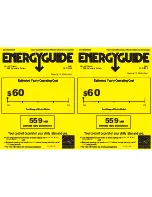
- 23 -
Refrigerator:
• Store the food only packaged or covered
in the refrigerator, in order to sustain the
flavour and the freshness. Especially foods
with a strong smell or prone to absorbing
smell (cheese, fish, butter, among others)
have to be stored separately.
•
At first, set an average cooling temperature.
If the cooling is too strong, set a higher
temperature and if the cooling is too weak,
set a lower temperature.
If frost is built upon the back wall, then
the cause of this could be that the door
was opened too long, warm dishes were in
the appliance or the temperature was set
too low.
• Warm foods have to be cooled down to
room temperature before they can be
stored in the appliance.
• Make sure that the door is closed correctly
and that it is not blocked by cooled food.
Ice Cube Production
There is an ice cube maker for making ice
cubes. Place the ice cube tray in the ice cube
maker. Pour drinking water through the filling
opening until the tray is filled to ¾. Insert
the ice cube maker into the Freezer. When
using the Fast Freezing function, the freezing
process takes about one hour.
By turning the knob to the right, the ice cube
tray can be turned. The ice cubes are dis-
solved and can then be removed or left in the
ice cube maker for storage. If the ice cubes
cannot be removed, let them thaw briefly
and turn the tray back and forth a few times.
Clean the ice maker regularly with water and
a little detergent.
Cleaning and Defrosting (Maintenance)
Cleaning
• Always pull the mains plug before cleaning.
• Do not pour water into the appliance.
• Tepid water with a bit of washing-up liquid
is suitable for the regular maintenance. In
order to avoid an unpleasant smell in the
cooling room, a cleaning of the latter once
a month is recommended.
• Clean the equipment separately with rins-
ing water, not in the dishwasher.
• Do not use aggressive, abrasive or alcoholic
detergents.
• After cleaning it with clear water, wipe the
surface and carefully dry it off. Subsequent-
ly, plug the mains plug
with dry hands
.
• In order to save energy and maintain the
efficiency, you should clean the condenser
(on the backside) and the compressor at
least twice a year with a broom or vacuum
cleaner.
• The rating label in the interior of the appli-
ance cannot be damaged or even removed
while cleaning.
Defrosting
The appliance does not have to be defrosted,
just cleaned. The evaporator is in the back
wall. Therefore, the back walls in the cooling
room can get covered with frost. Whenever
the compressor is not operating, the frost can
melt. The occurring water is guided through a
hose system into a bowl on the compressor,
where it is vaporised by the occurring heat.
Tips for Energy Saving
• For the installation of the appliance, choose
a cool, dry and well-aired room.
• Protect the appliance from direct insolation.
It should not be installed near heat sources
(stove, heater etc.). If this cannot be avoid-
ed, some sort of isolation between heat
source and appliance has to be used.
• Don’t cover the ventilation openings and
grid. Provide enough circulation of air on
the backside of the appliance.
• Let warm food cool down before you store
it in the fridge.
• Do not leave the door open too long when
withdrawing or putting food inside. Other-
wise, the formation of ice in the interior will
be accelerated.
• Do not set the temperature lower than
necessary. More details on temperature
settings can be taken from the chapter
‘Controls and Display’.
Operation Noises
There might be some typical operation noises
when the appliance is turned on. These are:
• Noise of the electric
motor is arising from
the working compressor.
When the compressor
starts to operate, then
the noises get slightly
louder for a short time.
• Noises in the tubes of the circulation of the
refrigerant.
















































